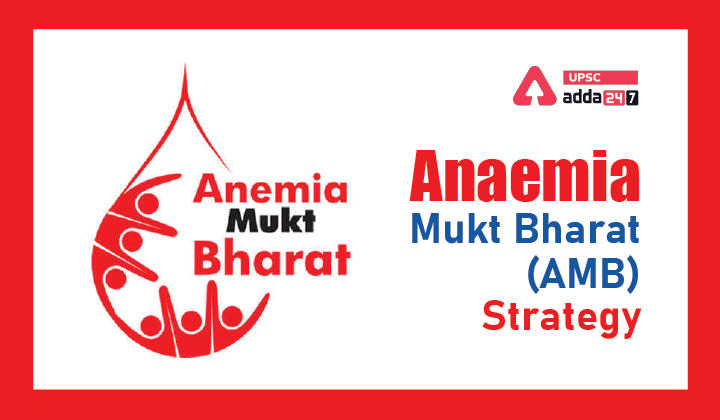Table of Contents
Anaemia Mukt Bharat (AMB) Strategy- Relevance for UPSC Exam
- GS Paper 2: Governance, Administration and Challenges
- Government policies and interventions for development in various sectors and issues arising out of their design and implementation.
Anaemia Mukt Bharat (AMB) Strategy in News
- Recently, Union Minister of State for Health and Family Welfare informed the Rajya Sabha about various interventions taken by the government to address anaemia under Anaemia Mukt Bharat (AMB) Strategy.
Anaemia Mukt Bharat (AMB) Strategy
- About: The Government of India implements Anaemia Mukt Bharat (AMB) strategy under POSHAN Abhiyaan with the target for reducing anaemia among Indian people.
- Mandate: The Anemia Mukt Bharat strategy has been designed to reduce prevalence of anemia by 3% points per year among children, adolescents and women in the reproductive age group (15–49 years), between the year 2018 and 2022.
- 6X6X6 strategy: Government aims to provide preventive and curative mechanisms through a 6X6X6 strategy including six target beneficiaries, six interventions and six institutional mechanisms for all stakeholders to implement the strategy.
- Target Groups: Anaemia Mukt Bharat (AMB) Strategy aims to reduce anaemia in the six population groups –
- Children (6-59 months),
- Children (5-9 years),
- Adolescents girls and boys (10-19 years),
- Pregnant women,
- Lactating women and
- Women of Reproductive Age (WRA) group (15-49 years) in life cycle approach.
- Implementing Ministry: Ministry of Health and Family Welfare is implementing the Anaemia Mukt Bharat (AMB) Strategy.
- Implementation Areas: The Anemia Mukt Bharat strategy will be implemented in all villages, blocks, and districts of all the States/UTs of India.
- Implementation will be done through existing delivery platforms as envisaged in the National Iron Plus Initiative (NIPI) and Weekly Iron Folic Acid Supplementation (WIFS) programme.
Status of Anaemia in India
- As per the fifth round of National Family Health Survey (NFHS), conducted by MoHFW during the year 2019-21, the prevalence of anaemia is –
- 0 percent in men (15-49 years)
- 0 percent in women (15-49 years)
- 1 percent in adolescent boys (15-19 yrs),
- 1 percent in adolescent girls,
- 2 percent in pregnant women (15-49 years) and
- 1percent in children (6-59 months).
- Thirteen (13) States/UTs have reported decline in prevalence of anaemia among women age 15-49 in NFHS-5 as compared to NFHS-4. Name of these States/UTs are-
- Andhra Pradesh,
- Andaman and Nicobar Island,
- Arunachal Pradesh,
- Chandigarh,
- Dadra and Nagar Haveli and Daman and Diu,
- Haryana,
- Himachal Pradesh,
- Lakshadweep,
- Meghalaya,
- NCT of Delhi,
- Tamil Nadu,
- Uttar Pradesh and
- Uttarakhand
Major Interventions by Government under AMB Strategy
- Prophylactic Iron and Folic Acid Supplementation.
- Intensified year-round Behaviour Change Communication (BCC) Campaign and delayed cord clamping.
- Testing of anaemia using digital methods and point of care treatment.
- Addressing non-nutritional causes of anaemia in endemic pockets with special focus on malaria, hemoglobinopathies and fluorosis.
- Convergence and coordination with line department and other ministries.
- Engaging National Centre of Excellence and Advanced research on Anaemia Control for capacity building of health care providers.
- Monitoring progress in States/UTs using Anaemia Mukt Bharat Dashboard.




 TSPSC Group 1 Question Paper 2024, Downl...
TSPSC Group 1 Question Paper 2024, Downl...
 TSPSC Group 1 Answer key 2024 Out, Downl...
TSPSC Group 1 Answer key 2024 Out, Downl...
 UPSC Prelims 2024 Question Paper, Downlo...
UPSC Prelims 2024 Question Paper, Downlo...
